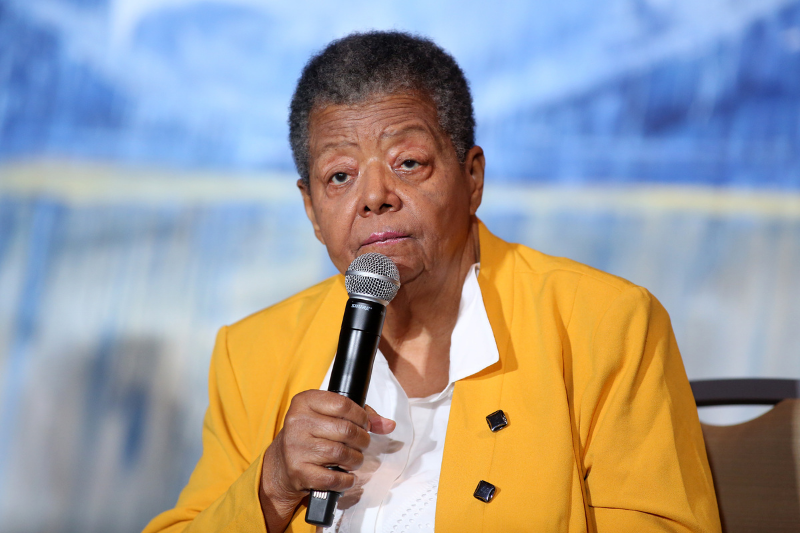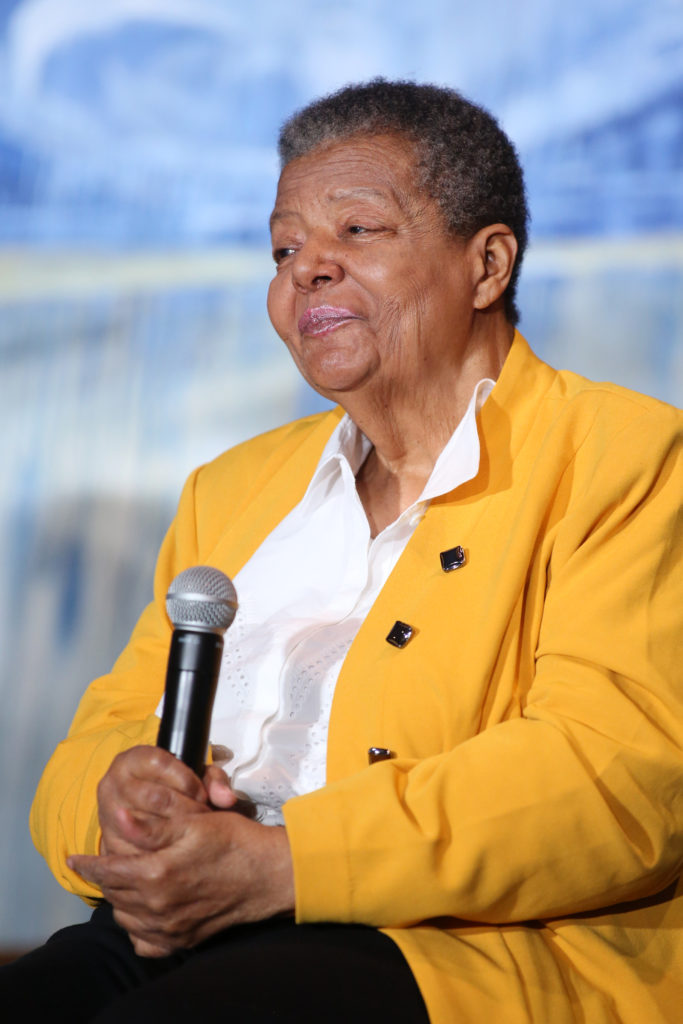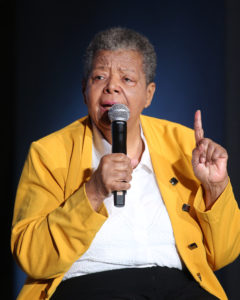Elizabeth Eckford is encouraging others to speak because one voice can make a difference.

Elizabeth Eckford, a native of Little Rock, has long been remembered as one of nine students who desegregated Little Rock Central High School during a violent political and physical standoff with armed troops and an angry white mob during the fall of 1957.
At a virtual keynote speech during the National Federation of Press Women annual conference in June that was sponsored by Arkansas Business, Eckford said what she and her fellow students did wasn’t really integration.
“We have a difference in terms,” Eckford said. “I never described my experience as integration or an attempt at integration. We were never treated as equals. What happened is desegregation. The school district intended limited, token desegregation. We were told early on that we could not participate in any extracurricular activities. Regardless of what was said to us or done to us, we could not retaliate, we could not talk back.”
Several of the children grew up to write books about their experiences, but Eckford didn’t talk publicly about what happened at Central High School until she was much older. She recently published a children’s book about that time and said she felt more empowered to share her story in recent years.
“Among the Little Rock Nine, there is one who refuses to talk about our school experiences, not even with his family,” she told Emily Jefferson, a Little Rock Central High School journalism student who interviewed Eckford during the session. “The other eight of us never talked about what it was like inside school for 30 years. To do so is very difficult. It is a walk through pain to talk about the past until you reach a point where it becomes purposeful. I didn’t start talking about it until 1997. It was because I couldn’t bear the stories that were being told in the local press that were a denial of what happened.”
 Reliving the past is still a difficult experience for Eckford, who has post-traumatic stress disorder after the events at Central High School. She is more comfortable talking with children about what happened, giving credit to her few years as a social studies teacher for why she makes an effort to talk more with students.
Reliving the past is still a difficult experience for Eckford, who has post-traumatic stress disorder after the events at Central High School. She is more comfortable talking with children about what happened, giving credit to her few years as a social studies teacher for why she makes an effort to talk more with students.
“Over a period of time, I reached a point where I no longer cry but I am still intentional in talking about the past,” Eckford said. “I want people to understand that ordinary people in extraordinary circumstances can do extraordinary things. Sometimes, all you can do is try to hold on, try to keep going.”
The teenage Eckford never dreamed that going to Central High School would turn into an international symbol of the fight for civil rights. She said she always saw the high school as a path to a better education, something that was highly valued in her family. Eckford’s own mother had run away from home and traveled to Little Rock to finish high school because the school in her small farming town stopped after eighth grade.
“My mother, my grandfather, my father, everybody looked at education as a way of achieving more opportunity,” Eckford said. “She saw the attempt of desegregation as a way for me to get a better education, to be better prepared for college. Even though I came from a working-class family, I grew up with the expectation that I would go to college, but I knew I had to have scholarships in order to go to college. I wanted to be as well prepared as possible. That was my reason for wanting to go to Central.”
Eckford recalls how terrified she was the morning of Sept. 4, 1957, as she tried to walk to the safety of a bus stop after being turned away from Central High School multiple times by armed Arkansas National Guard soldiers. She was then followed by the enraged mob members and reporters as she made her way to a bus stop.
“I didn’t respond to the questions from the reporters because I was afraid if I opened my mouth, I’d lose control and cry openly,” she said. “I concentrated on getting to the bus stop. Of course, I was terrified. As I got to the bus stop, two middle-aged reporters who were education writers for the Washington Post and New York Times welcomed me, and one of them said, ‘Don’t let them see you cry.’ When that white man put his arm across my shoulder to comfort me, it increased the anger of the crowd.”
Eckford remembers being disappointed by the lack of response in the Little Rock area at the time, and feels the need to let everyone know that just one voice can make a difference.
“When I talk about the past, I use the oral history as a way to get around to what I really, really want to say,” Eckford said. “Every voice in the community is important. Opposition to desegregation rose vociferously the summer before the fall term, but we didn’t hear anything from the usual business leadership of Little Rock. The only contrary voices were the voices of NAACP. There were not people taking a stand for following the court order or for just doing what the law required. There were very few contrary voices.”
On the fateful morning of Sept. 4, 1957, Will Counts of the Arkansas Democrat took a famous photograph of Eckford walking away from Central High School with members of the mob in pursuit. The photo was nominated for a Pulitzer Prize in 1958. People all over the world wrote to Eckford. She recalls the photo was shown in classrooms in South Africa, and there was once a three-story mural depicting the scene on a building in Northern Ireland.
 “We received letters from people all over the world, but we were concentrating on just trying to survive at Central. Having supportive letters did help. It made me feel less alone,” Eckford said. “After a while, I became weary of the attention from the press. Whenever I was away from Little Rock, I had a reprieve. I had years of anonymity so long as I was not in Little Rock. I sought that anonymity once when I was in an office and there was a mention of us in The New Yorker magazine. I asked them to take that issue out of circulation so my coworkers would not encounter it.”
“We received letters from people all over the world, but we were concentrating on just trying to survive at Central. Having supportive letters did help. It made me feel less alone,” Eckford said. “After a while, I became weary of the attention from the press. Whenever I was away from Little Rock, I had a reprieve. I had years of anonymity so long as I was not in Little Rock. I sought that anonymity once when I was in an office and there was a mention of us in The New Yorker magazine. I asked them to take that issue out of circulation so my coworkers would not encounter it.”
In 2018, Eckford decided to share her story through a children’s book, The Worst First Day: Bullied While Desegregating Little Rock Central High. The book, co-authored with Eurydice and Grace Stanley, is Eckford’s first autobiography.
“Violence in school was not common in the 1950s, but it was part of our everyday experience,” Eckford said. “People who were in school started to pretend that they didn’t know what was happening. Certainly, I thought people would talk among themselves about what they had seen or heard. I saw people turning their backs and walking away. That made me feel like they thought we were getting what we deserved. That’s why the book is intentional in that I want young people to understand that there are things they can do. I never ask them to defend someone who is being harassed. I simply ask them to treat people in a way they want to be treated.”
Nearly 64 years after the events of Central High School, Eckford sees echoes of the past mirrored in today’s racial protests. She said acknowledging past wrongs is the only way to achieve racial healing throughout the country.
“You can never have true reconciliation until we honestly acknowledge our pained but shared past,” Eckford said. “We have to be honest about our history. People who have suffered at least want people to acknowledge the suffering even if they’re not sympathetic to it. They want that acknowledgement.”

